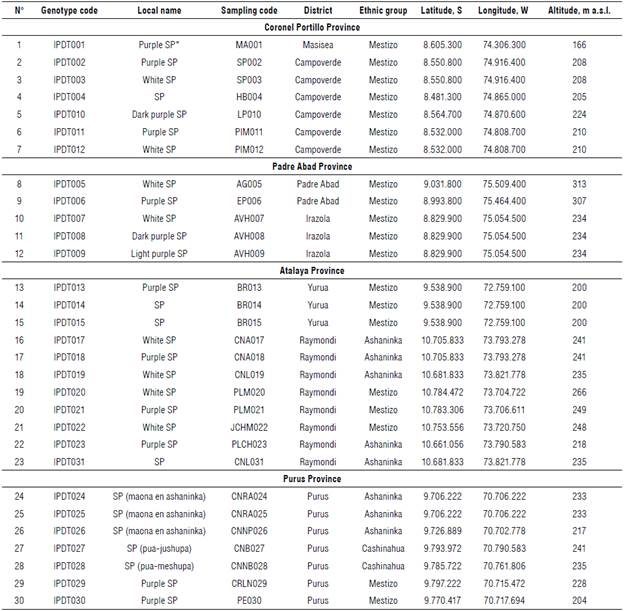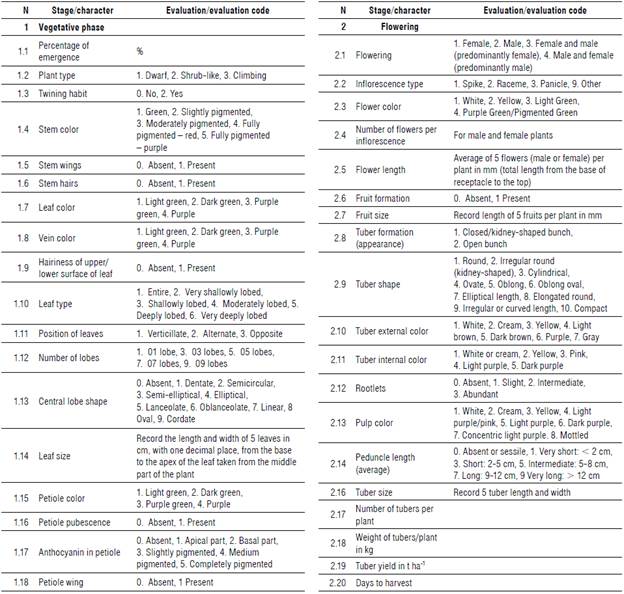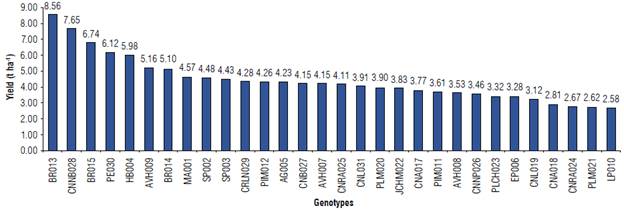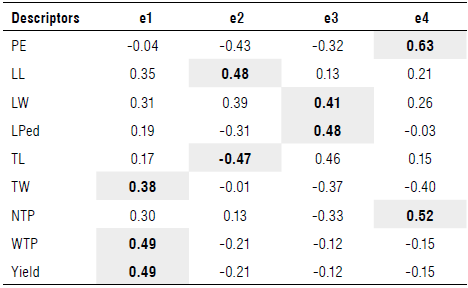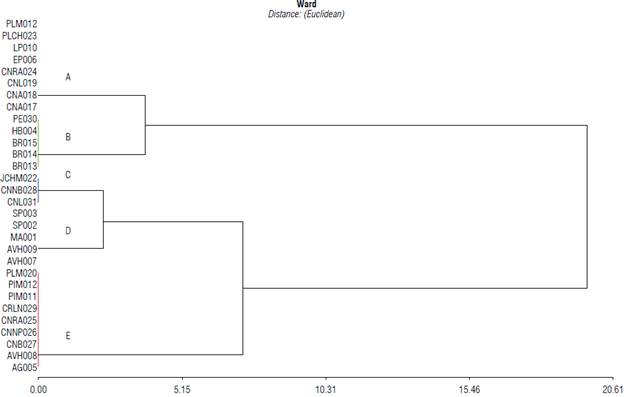Introduction
The Amazon region is home to many resources for food; one of these is Dioscorea trifida L. f., known as sachapapa (common ñame in Peru) or yam. It is a tuber plant belonging to the Dioscoreaceae family. Viruel et al. (2016) refer to three genera that group the Dioscoreaceae family (Stenomeris, Trichopus, Rajania, and Dioscorea), and the World Checklist of Vascular Plants (2022) accepts 679 species for Dioscorea (15 edible and medicinal approximately), providing substantial food for more than 100 million people in the humid and sub-humid tropics, appreciated for their flavor and fine texture (Price et al., 2018; Padhan & Panda, 2020). The Dioscorea species grow in Southeast Asia, tropical America, and West Africa, in tropical and subtropical regions of the world (Kumar et al., 2017). According to Montaldo (1991), in the upper and lower jungle of the Peruvian Amazon, it constitutes a main source of energy in the diet of the inhabitants. As a crop, Dioscorea species requires much light and humid soils with good drainage. Padhan and Panda (2020) reviewed the aggregate nutritional composition of old-world yam and reported that its tuber is a good source of essential nutritional compounds, such as starch, protein, lipids, vitamins, and minerals, which agrees with the description of Pérez et al. (2009) for the nutritional composition of three varieties of Dioscorea trifida in the Venezuelan Amazon. Moreover, Ramos-Escudero et al. (2010) determined the content of total polyphenols, flavonoids, tannins, and anthocyanins for D. trifida, finding values around 166.10, 27.63, 9.62, and 21.59 mg/100 g of dry matter, respectively. Furthermore, pigments of yam pulp tuber have the capacity to sequester free radicals. This indicates a good in vitro protective effect of the pigments extracted from sachapapa (D. trifida). The aforementioned studies reveal the importance of sachapapa for food and health, although there are few studies regarding its agronomic management, origin, geographical distribution, and genetic variability of its populations (Nascimento et al., 2015; Arnau et al., 2017). In the Ucayali region (Peru), the production of sachapapa reaches an approximate average of 612.11 t per year (Astete-Verde, 2019), although it is considered a neglected crop because it is mainly cultivated for subsistence by native communities using traditional agricultural practices. In order to develop strategies for the management and conservation of this crop, the genetic diversity must be agro-morphologically characterized (Ocampo et al., 2021; Thakur et al., 2021; Wada et al., 2021). In this context, the objective of this research was to evaluate the genetic variability using morphological descriptors for 30 Dioscorea trifida genotypes. This is a broad germplasm collection maintained and conserved year after year in rotation plots under similar environmental conditions, thus ruling out environment as the cause of observed morphological differences.
Materials and methods
Germplasm collection
In 1997, the National Institute of Agrarian Innovation (INIA), through the Genetic Resources Subdirectorate, began the collection of D. trifida germplasm. By 2000, 30 accessions from the four provinces of the Ucayali department (Fig. 1, Tab. 1), were collected to maintain and conserve in experimental plots a Campoverde Annex of the Pucallpa Agrarian Experimental Station (Federico Basadre Highway, Km. 44, Campo Verde district, Coronel Portillo province, Ucayali department, at coordinates 8°22'00" S and 74°34'80" W, altitude 205 m a.s.l.). The climate of the experimental area is characteristic of the lowland tropical zones; it is humid and warm without marked variations in the annual average temperature and with a defined strong dry season from May to July, with a relative humidity about 70-90%.
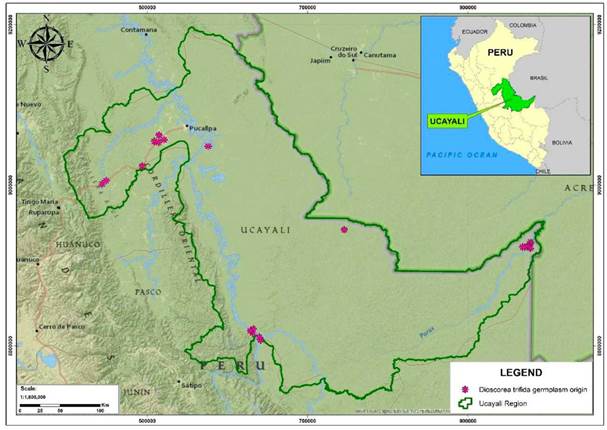
FIGURE 1 Map of Dioscorea trifida germplasm origin in the Ucayali region. Each circle represents the geographic origin of the sachapapa germplasm part of the National tropical root and tuber germplasm collection.
Field characterization plots
The 30 accessions of D. trifida were sowed at a distance 2 m between rows and 1 m between plants, with a localized application of 800 kg ha-1 of island guano and in some cases 10 t ha-1 of chicken manure; it was also necessary to install stakes that serve as a support because Dioscorea trifida is a climbing species. Field characterization plots were located in the same place as the field germplasm collection described above and plot rotation (50 m of distance between each plot) was applied every year from 2008-2017.
Descriptors
To assess genetic variability, 26 qualitative and 12 quantitative descriptors were evaluated (Tab. 2). Of the 178 descriptors listed by the International Institute of Plant Genetic Resources for Dioscorea spp characterization (IPGRI, 1997), 38 descriptors were adapted by the researchers according to the basic morphology of Dioscorea trifida.
Experimental design and data analysis
The experimental design was completely randomized with 10 repetitions (years). Rotation plots were evaluated for 10 years. Each year sowing started at the end of October, flowering took place after 5-7 months and harvesting began after approximately ten months. The climatic condition around each plot location was usually characterized by a rainy season around October 15th to April 15th, followed by a dry season from mid-April until the beginning of October. In every plot, we installed thirty accessions with ten plants per accession. For quantitative variables, five plants from the third to the seventh were selected and evaluated. For qualitative variables, we used direct observation to the ten plants and considered the most frequently occurring attribute observed.
Simple descriptive statistics were obtained for all variables. The Chi-square test was performed for each qualitative character. The phenotypic diversity for the qualitative variables was determined using the Shannon-Weaver genetic diversity Index (H'). The range of H' is from 0 to 1, where 1 indicates maximum diversity. H' is defined as H' = ΣP1Log2P1, where Pi is the proportion of the total number of genotypes belonging to each category. According to Jamago (2000), H' is classified as low (H'<0.50), intermediate (H'=0.50-0.75), and high (H'>0.75). To determine the similarity between the D. trifida germplasm, a hierarchical cluster analysis (CA) was done with Ward's clustering method using Euclidean distance. To determine the occurrence of statistical differences between the groups of the dendrogram, a one-way analysis of variance was performed, and the Tukey test was used (P≤0.05). A Pearson correlation analysis was added between quantitative descriptors. Likewise, a principal component analysis (PCA) of the twelve quantitative variables under study was carried out. StatGraphics V. 19 software (StatGraphics, 2009) was used for all analyses.
Results and discussion
Qualitative descriptors
Of the 26 qualitative characters evaluated in 30 genotypes of D. trifida, eleven (11) were not discriminating (Tab. 3) and allows the species to be described as having a climbing habit with a twisted appearance, with wings, but without pubescence on the stem. The leaves are alternately arranged, without pubescence and with light green veins. Pubescent wings are recorded on the petiole. In all genotypes, spike-type inflorescences with light green flowers were observed. Nascimento et al. (2015) also reported genotypes of D. trifida with climbing plant behavior, with winged polygonal stems and green petioles with brown pigments and alternate leaves.
About fifty eight percent of the qualitative characters evaluated for 30 genotypes of D. trifida resulted discriminant. According to the Chi-square analysis and the Shannon-Weaver Genetic Diversity Index (H') (Tab. 4), the most variable qualitative characters of D. trifida are: petiole anthocyanin (0.86), internal tuber color (0.86), petiole color (0.81), and stem color (0.80). While the number of lobes and the color of the mature leaf were the characters with the least variability (0.35), which would be consider as low variability (Jamago, 2000). The morphological variability of Dioscorea spp. was also determined using the Shannon-Weaver Genetic Diversity Index (H') of Islam et al. (2011). These authors also found high diversity indexes for petiole color and tuber shape in Dioscorea alata and Dioscorea bulbifera.Moreira et al. (2017) evaluated the external color and tuber shape of Dioscorea cayennensis, finding a low diversity index, which is expected for descriptors with fewer categories.
TABLE 4 Absolute frequency, proportion, and variability within 16 qualitative descriptors of Dioscorea trifida.
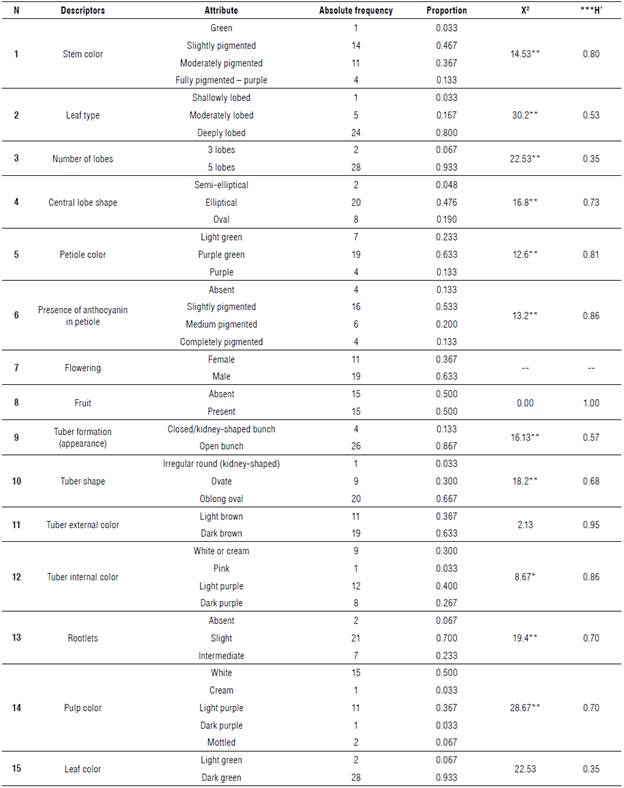
* Significant Chi-square, ** Highly significant Chi-square (X2), *** Shannon-Weaver Genetic Diversity Index (H').
The slightly pigmented color predominated for the stems, which are green with purple or brown pigments. The predominant color of the petiole was purple green, characteristics that coincide with the description for D. trifida genotypes reported by Nascimento et al. (2015) in three states of Brazil. Similarly, the number of lobes per leaf can vary from three to five, although five-lobed leaves were predominant.
This result is in sharp contrast with Dioscorea alata, a species characterized by single lobe leaves (Norman et al., 2011). The color of the pulp for Dioscorea species ranges from white, yellow to dark purple (González, 2012). In this study, white pulp color (50%) was predominant, followed by light purple (36.7%), consistent with the results of other studies (Pérez et al., 2009; Nascimento et al., 2015). Pérez et al. (2009) analyzed the nutritional content of D. trifida with three colors of pulp, finding a higher content of crude protein in white pulp (6.8 ± 0.02%) in contrast to the values for purple pulp (4.3 ± 0.54%).
Quantitative descriptors
Values regarding the descriptive statistics analysis for 12 quantitative descriptors evaluated in 30 genotypes of D. trifida are shown in Table 5. The descriptors with the highest coefficient of variation are tuber weight per plant (33.01) followed by tuber yield (32.99) and the number of female flowers per inflorescence (27.42%).
TABLE 5 Descriptive statistics of 12 quantitative descriptors from the evaluation of 30 genotypes of Dioscorea trifida.
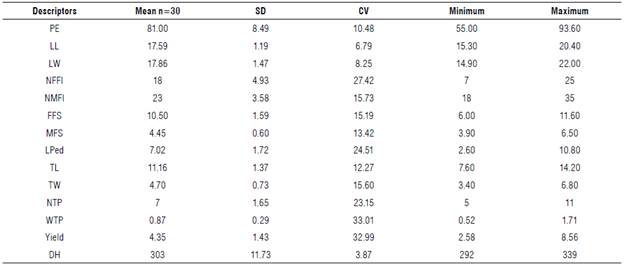
SD: Standard deviation; CV: Coefficient of variation PE: Percentage of emergency; LL: Leaf length; LW: Leaf width; NFFI: Number of female flowers per inflorescence; NMFI: Number of male flowers per inflorescence; FFS: Female flower size; MFS: Male flower size; LPed: Length of peduncle; TL: Tuber length, TW: Tuber width; NTP: Number of tubers per plant; WTP: Weight of the tubers per plant; DH: Days to harvest.
Taking into account the coefficients of variation and the ranges of the quantitative variables, wide genetic variability is suggested. However, it is important to evaluate and consider which characteristics are truly inherited and the edaphoclimatic factors that can influence the agro-morphological variation and the management of the genotypes of D. trifida for genetic improvement purposes. For example, the genotypes with the highest yield were BR013 and CNNB028. This yield, in addition to other physicochemical characteristics (Carlos et al., 2020), must be evaluated under different environmental conditions prior to technology transfer to farmers. Figure 2 shows the yield in tons per hectares by each D. trifida genotype, an important trait to select genotypes for genetic improvement and food security.
Correlation analysis
Leaf width and length, tuber weight per plant and tuber width, tuber yield per plant and tuber width, correlated in a positive and highly significant way (Tab. 6). Peduncle length and tuber length as well as leaf length and number of tubers per plant showed significant and positive correlations.
TABLE 6 Pearson's correlation analysis between nine quantitative characters for Dioscorea trifida.

PE: Percentage of emergency; LL: Leaf length; LW: Leaf width; LPed: Length of peduncle; TL: Tuber length, TW: Tuber width; NTP: Number of tubers per plant; WTP: Weight of the tubers per plant.* Significant at 5% level; ** Significant at 1% level.
Principal component analysis
Four components were selected that may explain 86% of the variability among D. trifida genotypes (Tab. 7). The first component is constituted mainly by tuber traits: tuber width, tuber weight per plant, and tuber yield (38%). The second component is made up of the descriptors: leaf length and tuber length (20%). The third component is represented by peduncle length and leaf width (17%). Tuber yield and tuber length are included in the set of priority descriptors for characterization of Dioscorea genetic resources (Biodiversity International and International Institute of Tropical Agriculture (IITA), 2009), therefore, it is consistent with the principal component analysis.
Clustering analysis
Clustering analysis distributed the 30 sachapapa genotypes in different clusters based on the Euclidean distance in a range from 0 to 20.63. The dendrogram identified five groups using a cut distance of 5.15 (Fig. 3, Tab. 8). Groups B and D comprise five genotypes each, group C has three genotypes, and groups A and E have eight and nine genotypes, respectively. Among the groups, the descriptors with statistically significant differences are emergence percentage, leaf length, leaf width, number of flowers per cluster, number of tubers per plant, and days to harvest (Tab. 8). Group C registered the lowest percentage of emergence, while group B registered the highest percentage of emergence. Likewise, the group with the longest leaf length and width was group C (19.38 cm and 20.34 cm, respectively), while group E was made up of genotypes with the smallest leaf size (16.47 cm and 16.34 cm). Group C registered genotypes with the highest number of flowers per cluster and the longest peduncle length (28.16 cm and 8.58 cm, respectively). Regarding tuber traits, group D registered the highest number of tubers per plant (9), while groups A and E registered the lowest number of tubers per plant. Group В registered greater length and width of tubers (11.70 cm and 5.72 cm, respectively). This group also stands out with higher yield (6.50 t ha-1) ina shorter period (295 d on average) and with light purple pulp. Moreover, groups В and D comprise genotypes of the Mestizo ethnicity, therefore, the cluster analysis may reflect the grouping in relation to the ethnic group to which it belongs. In this context, a conservation strategy within ethnic groups would be to promote the repopulation of the diversity of sachapapa genotypes along with teaching agronomic management techniques applied in the germplasm collection of this study.
TABLE 8 Comparison of means between the groups formed in the cluster analysis.

PE: Percentage of emergency; LL: Leaf length; LW: Leaf width; LPed: Length of peduncle; TL: Tuber length, TW: Tuber width; NTP: Number of tubers per plant; WTP: Weight of the tubers per plant. Averages with different letters are significantly different at 0.05 P-value.
Conclusions
The morphological characterization of thirty genotypes of Dioscorea trifida using 38 descriptors revealed high variability for the qualitative characters of petiole anthocyanin, internal tuber color, pulp color, and stem color. The quantitative descriptors with the highest coefficient of variation were tuber weight per plant and tuber yield. Four main components can explain 86% of the variability of the 30 genotypes of D. trifida. Descriptors with the greatest contribution to variance are tuber width, tuber weight per plant, and tuber yield (38%). It was also possible to distinguish five groups based on the Euclidean distance and Ward hierarchical clustering method, where group В highlights with genotypes HB004, BR013, BR014, BR015, PE030 registering higher tuber yield in fewer days. This is a preliminary study aiming at assessing genetic variability of the germplasm collection rather than high yielding genotypes. For more reliable yield data, replicated trails in different locations would be required. Moreover, complementary studies of nutritional value and biochemical composition of these genotypes are suggested, so that they can be shared with the population and additional molecular analysis must be performed to support the basis for the genetic improvement of this species. In addition, the agro-industrial potential of yam pulp tuber color varieties for food and health should be analyzed.













